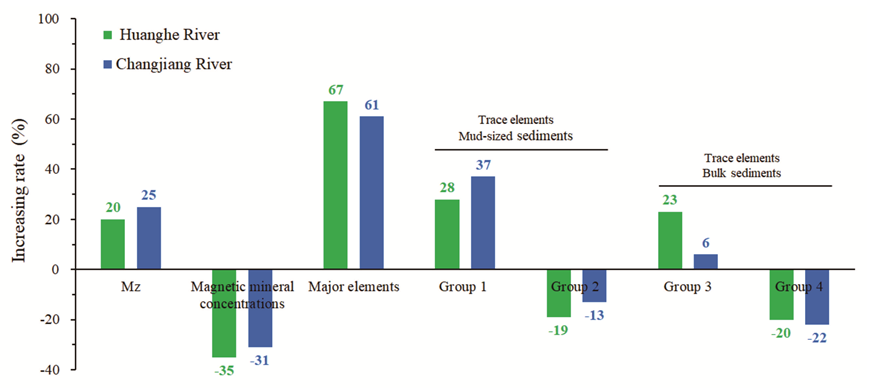人类活动引发的大河入海物质变化可能成为未来的地质时间标记
全球众多河流正面临着由高强度人类活动引发的系统状态变化,最直接的表现是入海物质通量的急剧减少和沉积物性质的变异,这些改变对河口海岸地区具有重大的环境、生态和社会影响。关于人类活动引起的河流入海通量变化已开展了诸多研究,但我们对于人类活动引起沉积物性质的变化及其对源-汇系统的影响却知之甚少。近几十年来,长江和黄河的泥沙通量急剧减少,可以作为研究人类活动改变河流入海沉积物性质的范例。研究结果表明,从建坝前(Pre-dam period)到建坝后(Post-dam period),长江和黄河入海沉积物性质(如粒度、磁学和地化元素)发生了显著的变化(图 1)。进一步的分析结果揭示,人类活动引起的沉积物性质变化,极大地放大了两条河流沉积物端元的差异(图 2)。这意味着在建坝后,使用先前建立的示踪指标识别两条河流的沉积物具有较大的不确定性。此外,沉积物性质的显著变化可以在沉积记录中留下不同的标记,时间分辨率为100 - 101年,这可能为受黄河和(或)长江影响的沉积记录提供未来的地质时间标记。这项工作将丰富我们对人类活动改变河流系统的认知,有利于在系统状态转换背景下对海岸带可持续开发利用进行战略评估。
该研究成果以“Human-induced changes in sediment properties and amplified endmember differences: Possible geological time markers in the future”为题发表于Science of the Total Environment期刊上,第一作者为杨阳博士,通讯作者为高抒教授。
图. 1. The increasing rate (%) in mean grain size (Mz),magnetic mineral concentrations (χ and SIRM values), and major and trace elements of the Huanghe and Changjiang sediments from the pre-dam period to the post-dam period. Mud-sized sediments: Group 1 represents Nb, Sr, Y, Hf, Cr and V, and Group 2 represents Th, Ga, Cu, Co and Ni. Bulk sediments: Group 3 represents Nb, Rb, Th, Zn, Cu, Cr and V for the Huanghe River, and only Sr for the Changjiang River; Group 4 represents Pb, Sr, Y, Hf, Co and Ni for the Huanghe River, and all the trace elements with the exception of Sr and Ga for the Changjiang River.
图 .2. The discrepancy factor (%) of magnetic and geochemical tracers in the mud-sized (a) and bulk (b) sediments of the Huanghe and Changjiang Rivers between pre-dam and post-dam periods.
-
Science of the Total Environment ,
2019 ,
661
: 63-74


